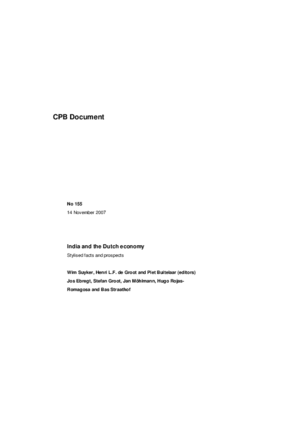India and the Dutch economy; stylised facts and prospects.
India increasingly important for Dutch economy
At present, Dutch-Indian trade is modest in size. Less than 1% of Dutch merchandise exports is destined for the Indian market. In this regard, the Netherlands is no different than other West European countries. However, rapid economic growth in India will fuel demand for Dutch products. Under the most favourable circumstances, Dutch exports to India may expand fifteen-fold up to 2040, while Dutch imports from India may grow even faster.
India and the Netherlands generally export different products, so competition between Indian and Dutch firms is unlikely to intensify. Therefore, India's emergence as an economic power will not lead to massive restructuring of Dutch industry. Investment by Dutch firms in India presently modest in scale is set to grow as consumer demand in India will continue to rise in coming years.
These are the main conclusions in CPB Document 155 India and the Dutch economy; stylised facts and prospects, published today. This is a joint study by researchers from the CPB Netherlands Bureau for Economic Policy Analysis and De Nederlandsche Bank. It has been conducted also at the request of the Minister of Trade and the Embassy of the Kingdom of the Netherlands in New Delhi.
Indian incomes are going up, starting from a very low level
Various economic policy changes, most notably trade liberalisation, have enabled income per capita in India to treble since 1980, reducing the poverty rate by half. Since the beginning of this century, income growth averages 7% per year. As a result, India has become the third largest economy in the world. Services exports are a major source of growth, having quadrupled over the last ten years. Nevertheless, average income in India is still very low: 10% of that in the Netherlands.
The Indian population will continue to grow rapidly. In 2030 India will overtake China as the worlds' most populous nation. This presents the Indian government with major policy challenges. In order to maintain economic momentum, further structural reform is required, most notably in manufacturing. In addition, measures need to be taken to combat mounting environmental hazards, to stop regional income disparities from widening further, and to improve public education. Insufficient supply of qualified workers is quickly turning into a serious bottleneck for Indian IT firms.
Dutch-Indian trade is still small
Trade flows between India and the Netherlands have increased markedly over the past ten years, bur are still rather small, considering the size of the Indian economy. Twenty-nine countries worldwide import more goods from the Netherlands than India. For every Indian container arriving at a Dutch port, there are over twenty-five arriving from China. At present, exports to India account for in between ten and fifteen thousand jobs in the Netherlands. But up to 2040, Dutch exports to India may grow by 5 to 10% annually. Even if global trade liberalisation comes to a halt, they will have trebled by that year.
Indian and Dutch exports generally consist of different products. India is strong at low-skill labour-intensive products, such as shoes and textiles, as well as IT-related services. The two countries experience little competition from each other on world markets.
Dutch firms rank fourth among foreign investors in India
By 2006, Dutch firms had invested 1.5 billion euro in India. That is just one quarter per cent of total Dutch oversees investment. All the same, during the last three years the Netherlands were the fourth biggest investor in India, after Mauritius, the United States, and the United Kingdom. Up to now, Dutch firms are not engaged in off-shoring specific services to India at a substantial scale. The principle motive for Dutch firms to invest in India is to gain a foothold in the fast growing Indian consumer market. If the Indian economy maintains its current momentum and the domestic market becomes increasingly open to foreign competition, Dutch investments in India will continue to rise. Meanwhile, Indian firms will also expand their oversees activities. A recent example is Tata Steel taking over Dutch-Anglo steel producer Corus. Such foreign investment is to the benefit of the Dutch economy.
Specific policy measures not required
The significance of India and other emerging economies for the Dutch economy is set to rise in years to come. As a result, Dutch consumers will benefit from the supply of a wide range of cheap products and Dutch firms will find new market outlets for their products. As happened in the past, such positive developments will entail structural adjustments. The adjustment process does not call for specific, new policy measures, however. The existing social security framework, coupled with active labour market programmes that enable workers to quickly change jobs, will suffice. In addition, ongoing structural change in the world economy requires strengthening Dutch firms' ability to innovate.
Read also the accompanying press release.
Increasing Indian exports did not have a noticeable impact on the pace of restructuring in the Netherlands. Nor did this development lead to a marked widening of Dutch wage differentials. Concerning global competition, Indian export products tend to be more complements than substitutes for Dutch export products. The large Indian market yields interesting investment opportunities for Dutch firms.
Over the next few decades, the Indian economy is expected to continue its rapid expansion. Increasing trade with India will continue and is expected to enhance Dutch welfare in the upcoming years and will continue to be associated with modest increases in competition and continued restructuring on some markets.
